If you’re a car owner, you may have found yourself in this situation before: You spend weeks or months car shopping, anticipating the day you can trade in your vehicle for a new and improved model. That day seems just around the corner, until one afternoon on your way home from work, you end up in a major accident. Luckily, you’re able to take your car to the shop, and though the repairs may be costly, your car is restored.
A few months later, you’re ready to trade in your vehicle. However, you’re surprised to discover that your car has lost value since your accident, even though the repairs restored your vehicle to near-perfect condition.
This change in your car’s worth is referred to as diminished value.
Find out more about:
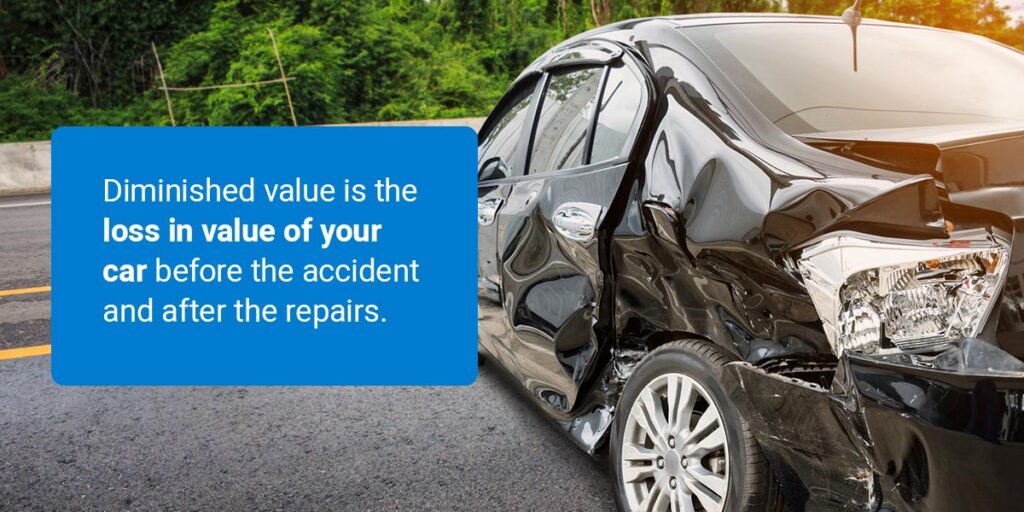
Diminished value is the loss in value of your car before the accident and after the repairs. After a car has been in a major accident, it generally has a lower resale value than it did pre-crash, depending on its age and condition. Even after high-quality repairs, potential buyers may not be willing to buy a car that has been previously damaged for as much money as you’re hoping.
Why might your car lose value after an accident? A minor car accident can significantly impact the vehicle’s value. Studies show values typically drop 10%, though this may vary based on repair costs and the extent of damage. More severe crashes often mean a greater reduction. The answer mostly boils down to perceived safety. Following an accident, a car might not be correctly fixed, or the parts might not be replaced with the original manufacturer parts. Every accident you’re in will go on your vehicle’s history report, and buyers will be able to see this history of accidents and repairs.
Why is it important to understand diminished value? If you ever intend to sell or refinance your car or you want to file a loss of value claim with an insurance company after you’re in an accident caused by another driver, then you’ll want to understand diminished value.
Say you’re looking to sell your used car for $10,000. You find an interested buyer, but after they find out your car was involved in an accident, they lower their offer to $7,000. The difference of $3,000 is the diminished value of your car. Because your vehicle was in an accident, it’s now worth $3,000 less.
This diminished value doesn’t apply to every car post-accident, however. Older vehicles can actually be worth more following an accident because new parts have replaced older parts after repairs. If your vehicle is a newer model, though, then diminished value may be a concern.
You may be able to file what is known as a diminished value claim. If you’re successful, the auto insurance provider will pay you to recoup the loss of value. For some drivers, successfully filing a diminished value claim may not be easy, and some restrictions may stand in your way.
Diminished value isn’t always simply a loss in value because of accident history. Other factors can also come into play to affect the type of diminished value you may be dealing with. There are three types of diminished value.
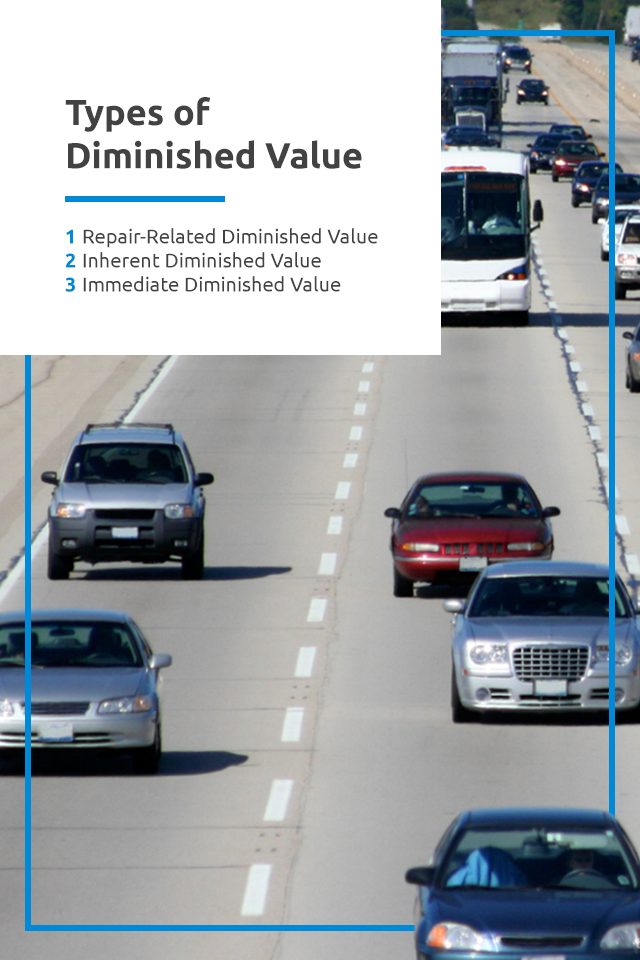
Following your accident, was your car repaired with aftermarket parts? Was your vehicle painted with a color that didn’t quite match the original coat? If a vehicle is subjected to low-quality repairs after an accident, this can lead to repair-related diminished value. This loss of value goes beyond the diminished value the vehicle suffers solely because of the accident — now you’re also dealing with a loss of value caused by poor quality repairs. If a vehicle cannot be restored to its original condition, the value of the vehicle will drop.
The most common form of diminished value is known as inherent diminished value, which simply means the car’s value has decreased because it has damage history. It’s assumed with inherent diminished value that repairs of optimal quality have been completed. This value also represents how much the car’s worth will drop due to its accident history.
This type of diminished value is not commonly used. Immediate diminished value refers to the difference in value immediately following a car accident and before repairs are made on the vehicle. This claim of loss is seldom used because most insurance companies will cover the majority of repairs right after an accident.
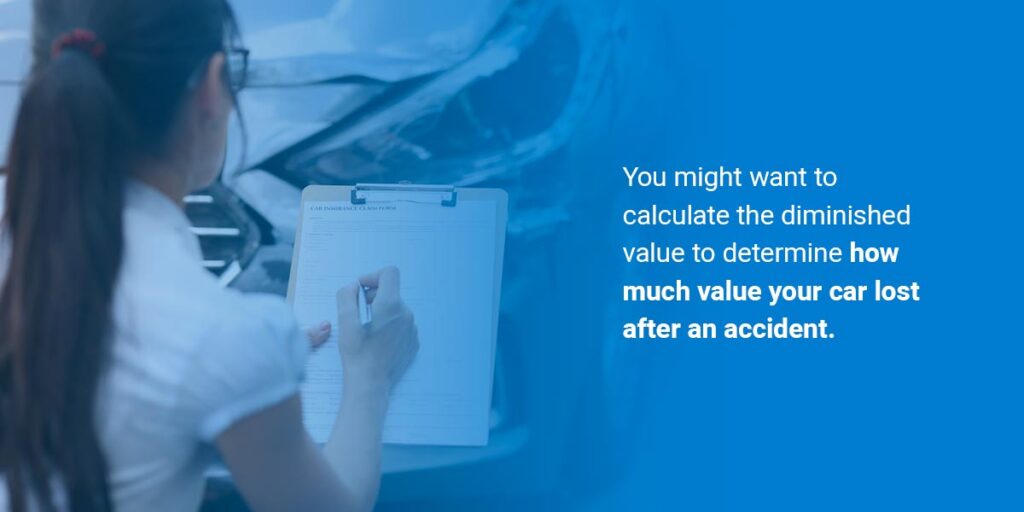
You might want to calculate the diminished value to determine how much value your car lost after an accident. However, you must first figure out your vehicle’s value before the accident. To do so, you can use Kelly Blue Book (KBB) as a resource. This site lets you input information about your vehicle and calculates the value based on data it compiles from wholesale auctions, dealers, rental fleets and private party transactions.
Your vehicle’s value will diminish after an accident, even if you perform all necessary repairs. But how do insurance companies in the U.S. calculate diminished value? Most carriers will use the 17c diminished value formula. This formula allows insurance companies to calculate a vehicle’s new value after an accident.
The following are the steps involved in calculating diminished value.
You can determine the value of your vehicle on your own by using websites that estimate car values. The National Automobile Dealers Association (NADA) is one such website that allows you to get an appraisal for the value of your car.
What information will you need to have on hand to get an accurate appraisal? To get an estimate, you may be asked to input some of the following information about your vehicle:
If you’re unsure what to enter for the vehicle’s condition, you may be able to take a quiz that will give you a better idea.
After you enter all the relevant information about your vehicle, you will get a price range for how much you may be able to sell your car for. You may also be able to compare the vehicle’s trade-in value with its private party value.
After determining an estimated value of your vehicle, insurance providers will often apply a cap of 10%. This cap is referred to as the base loss of value. The carrier will apply this cap to the sales value of the car to determine the maximum loss in value.
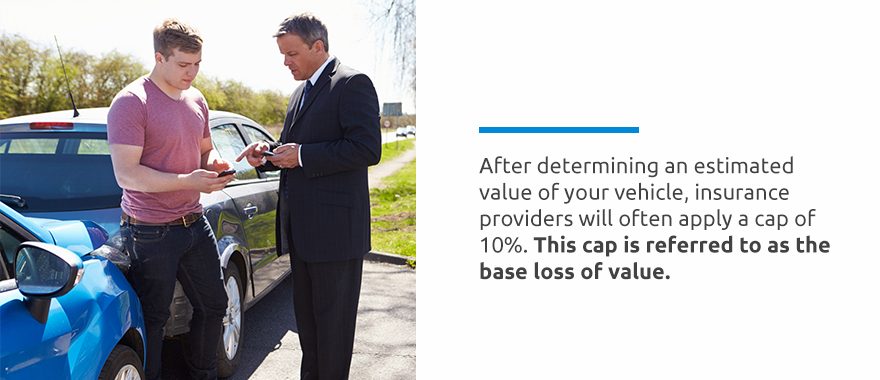
Insurance carriers assume your vehicle will not depreciate more than 10%, which is why 10% is the number they start with before applying additional multipliers to determine the final percentage of change.
For example, if your car is appraised at $5,000, the maximum loss in value is $500. If your car is appraised at $20,000, the maximum loss in value is $2,000. Take the appraisal value of your vehicle and multiply it by 0.1 to get your base loss of value.
After determining the base loss of value, your insurance company will then assess the damage done to your car. Based on this assessment, your insurance provider will then select a number between zero and one to indicate the severity of the damage and apply this number to their calculation:
As you can see, the one multiplier represents severe structural damage to the vehicle, while the zero multiplier represents no replaced panels or structural damage. This range of multipliers is not limited to numbers in 0.25 increments, though — it can include any number between zero and one, such as 0.15, 0.60 or 0.85.
After this multiplier is selected, it is then multiplied by the base loss of value calculated in the previous step.
But how do you know exactly what level of damage has been done to your vehicle? What exactly does severe structural damage mean? What damage can your car sustain while still retaining a multiplier of zero? Here’s a look:
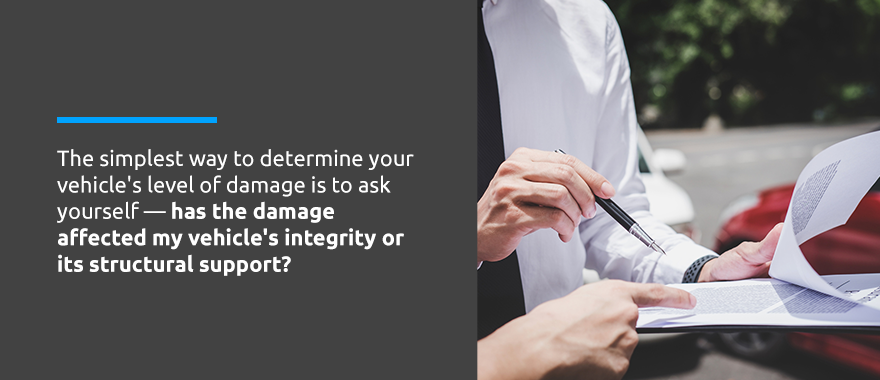
The simplest way to determine your vehicle’s level of damage is to ask yourself — has the damage affected my vehicle’s integrity or its structural support? Minor damage is typically surface-level, while major damage could impact the safety of your vehicle.
If you’re still not completely certain what level of damage your vehicle may fall under, select two multipliers for two separate calculations. This will at least give you a range of diminished value you can reasonably expect.
Though you may have already included your vehicle’s mileage when you calculated your car’s value with NADA, your insurance company will also calculate a mileage deduction themselves.
This multiplier reduces the adjusted base loss of value depending on the vehicle’s mileage. In this case, having fewer miles on your car could actually work against you:
The higher the mileage, the lower the multiplier. In this step, the value of older cars will be affected less than the value of a newer car. If the mileage on your vehicle is 50,000, for example, your adjusted value will be multiplied by 0.6.
Your insurance provider will apply one of these multipliers to the calculated value from the third step to determine your car’s final diminished value.
Now that you know how to calculate the diminished value of your vehicle, let’s combine the steps.
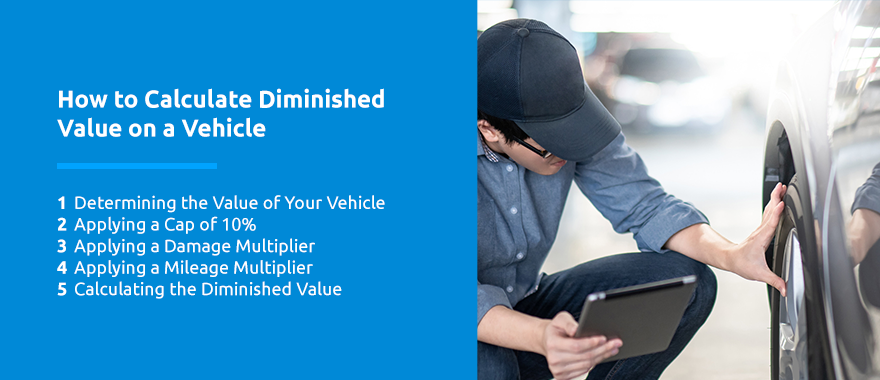
Say you were driving home from work one afternoon in your 2017 Honda Civic. You have the right of way through an intersection, but as you’re passing through, another driver pulls out without noticing you and hits your car.
First, let’s determine what your car was worth prior to the accident. You input all of the necessary information into a website to calculate your value estimate:
The trade-in value for your Honda Civic before your accident is $17,000.
Next, you’ll calculate your 10% cap by multiplying $17,000 by 10%. This comes out to $1,700. After being repaired, the maximum amount of value your vehicle can lose is $1,700.
During the accident, the other vehicle caused a large dent on the side of your car. This would be considered a moderate level of damage, giving you a damage multiplier of 0.50. After determining your multiplier, you multiply 0.5 by $1,700 to get $850.
Finally, you’ll determine the multiplier for your car’s mileage. Since your 2017 Honda Civic is just a couple of years old and has only 25,000 miles on it, your mileage multiplier is 0.80. Multiply $850 by 0.8 to get $680.
Post-accident, the value of your vehicle has decreased by $680. Subtract $680 from $17,000 to get $16,320.
Using the 17c method, we’ve determined the new value of your vehicle post-accident is $16,320.
Though not all insurance companies use the same calculation to determine diminished value, the 17c formula is a good starting point to give you knowledge about your car’s diminished value after an accident. When you’re aware of how much your vehicle is worth, you’ll be more prepared when you’re ready to sell it.
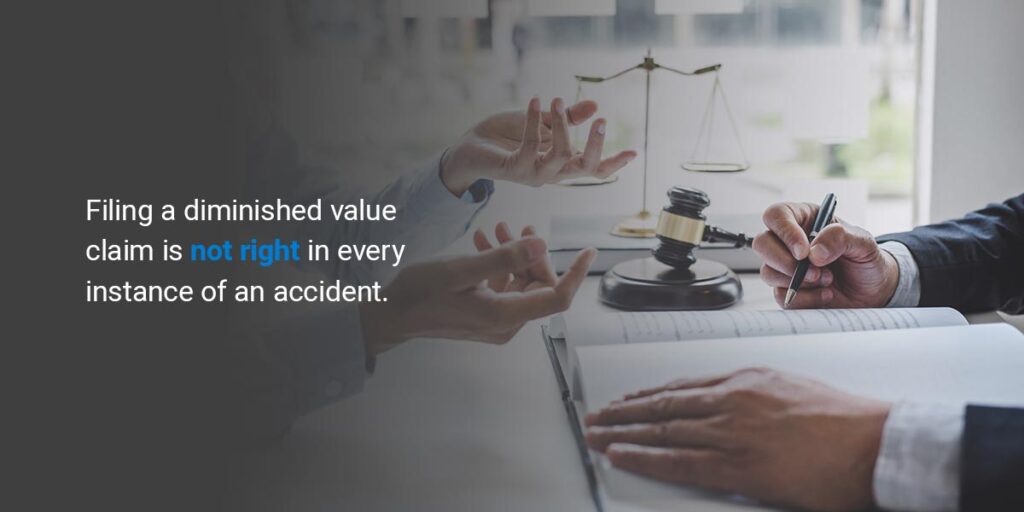
Filing a diminished value claim is not right in every instance of an accident. You are not guaranteed to receive a payout when you file a claim, so it’s wise to consider a few things before filing. These considerations include:
Many drivers aren’t aware that they may be entitled to their car’s diminished value after an accident. Based on Missouri Law, a driver must make a diminished value claim within at least five years to get the payout from their insurance company. To qualify for a claim, you must have auto insurance and you must not have been at fault in the accident.
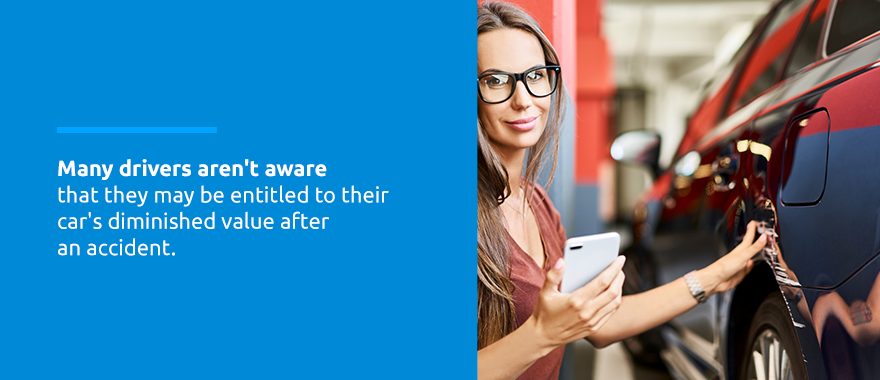
When you’re involved in an accident in which the other driver is at fault, you should file a diminished value claim to recover the loss in value. File your claim as soon as possible with the other party’s insurance carrier. When you file quickly, such as within a few days after the accident, you’ll be able to present your case with the appropriate supporting documentation more easily. The longer you wait to file, the more the value of your car could drop.
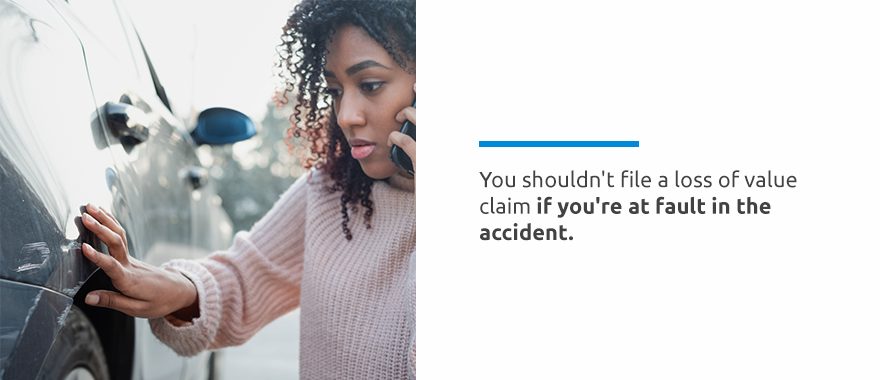
The longer you wait to file, the more the value of your car could drop. Additionally, most states impose a statute of limitations on diminished value claims. In Missouri, you have five years to initiate your legal proceedings relating to a diminished value claim.
On the other hand, you shouldn’t file a loss of value claim if you’re at fault in the accident. This is because drivers can’t typically file diminished value claims against their own insurance provider. You also cannot file a diminished value claim if the damage was the result of something other than a collision.
Check with your auto insurance company to determine if you qualify for accident forgiveness before you file a diminished value claim. Do this to ensure your insurance costs won’t increase while you’re going through the process of the diminished value claim.
Before you file your claim, you’ll also need to have the vehicle repairs completed. The insurance company will need the repairs to be completed so they can determine the diminished value of your car. You can also choose to take your car to a dealer or an appraiser so they can back up your loss of value claim.
Will you get diminished value coverage from your automotive insurance company? Whether your diminished value loss will be covered depends on a variety of factors. One of the key factors is which party is at fault for the accident.
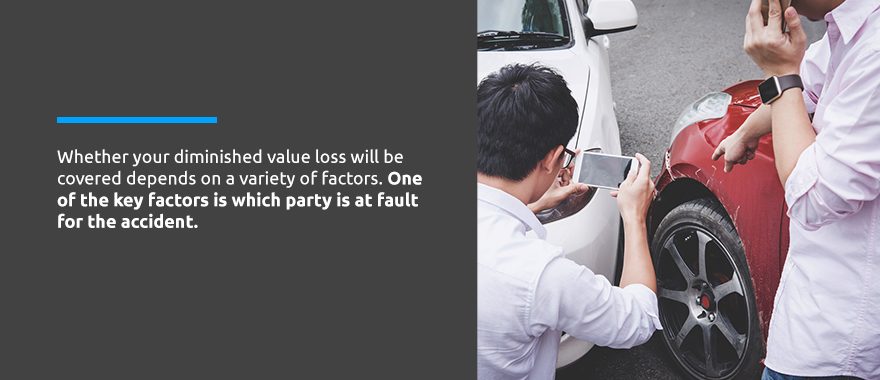
A claim against your insurance policy is known as a first-party liability claim. In many states, policyholders cannot get coverage for diminished value if they are at fault in the crash. However, if you are in an accident with an uninsured motorist, you should notify your insurance provider.
A claim against another driver’s policy is known as a third-party liability claim. If the other party is at fault for the accident, you can receive compensation for your vehicle’s diminished value. The insurance provider for the driver who is at fault must cover the repairs for your car and reimburse you for the difference in your car’s value from pre-accident to post-accident.
You’ll also need to prove that your repaired vehicle is now worth less than it was prior to the accident to obtain diminished value compensation.
If your car loses value after an accident, what can you do? Can you recoup the pre-accident value of your vehicle? It’s possible to do, and here’s how:
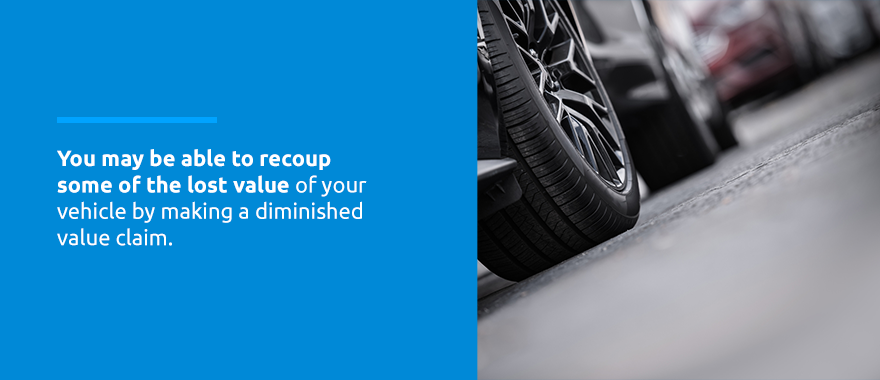
When it comes to claiming diminished value in Missouri, consider all the options at your disposal.
Check out a few frequently asked questions about calculating diminished value and making a claim.
Depreciation is not the same as diminished value. The depreciation of a vehicle refers to its drop in value over time — for example, a 2010 Honda Accord would be worth more in 2015 than in 2020. In general, a car’s value depreciates more in the first year than any other, losing around 20% of its original value. Diminished value is the calculation of a vehicle’s loss in value after a collision.
You can make a diminished value claim even if you live in a no-fault insurance state. No-fault insurance, also known as personal injury protection (PIP), means insurers offer coverage for medical expenses and income loss after an accident, whether or not you were at fault. Since no-fault insurance deals only with economic loss, you can still file a diminished value claim through your collision insurance or the other driver’s liability policy.
Classic cars are often old, but owners of these collectibles often pour lots of money and time into keeping their vehicles in good condition. If you’re involved in an accident with your classic car, you might wonder if you can file a diminished value claim. The answer is yes, but it will be a much more involved process.
If you want to file a diminished value claim for a classic car, you’ll likely need to get an approved appraisal to evaluate the value of your car before the accident and how the damage impacted that value.
At David Pope Insurance Services, LLC, we have over 20 years of experience in finding the right insurance solutions for individuals and families. We’re always looking for better ways to provide our clients with coverage to stay protected and safe without breaking their budgets.
Finding the right insurance policy doesn’t have to be challenging or stressful when you work with us at David Pope Insurance Services, LLC. Our goal is to make the process of finding the best insurance policy easier for residents of Missouri.
Are you a car owner in Missouri, Arkansas, Kansas or Iowa and in need of insurance? Contact us at David Pope Insurance Services, LLC or request a quote from us today.